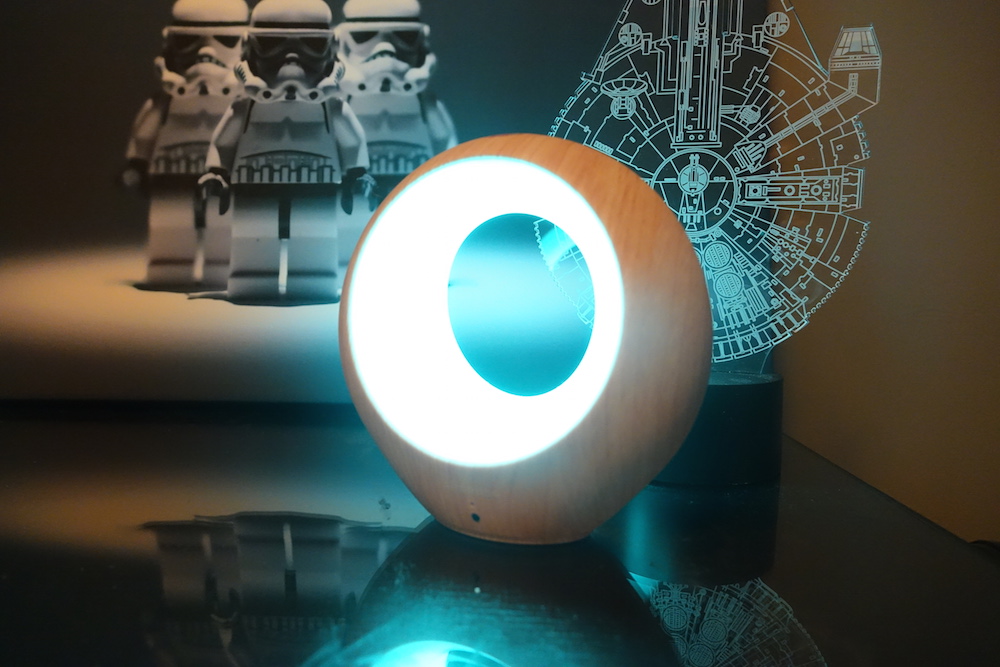 When Best Buy gave me the opportunity to review the iBaby Airsense Air Monitor and Ionic Purifier, it couldn’t have come at a better time. We had just purchased a humidifier and were using a large air purifier in my son’s room, having found it to be a bit too dry. So not only was having this device around for a few weeks a welcome addition, but it was also a timely one.
When Best Buy gave me the opportunity to review the iBaby Airsense Air Monitor and Ionic Purifier, it couldn’t have come at a better time. We had just purchased a humidifier and were using a large air purifier in my son’s room, having found it to be a bit too dry. So not only was having this device around for a few weeks a welcome addition, but it was also a timely one.
What is the iBaby Airsense Air Monitor and Ionic Purifier?
This smart, Wi-Fi-connected air monitor and ion purifier can detect volatile organic compounds (VOCs) in the air, including allergens and toxins, provide tips on living a healthy lifestyle pertaining to the air you breathe, purify the air when needed, and send smart 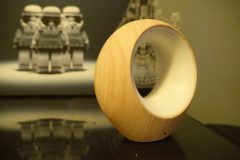 alerts related to air quality to your mobile device. But it does more as well, including functioning as an alarm, nightlight, music speaker, and audio monitor.
alerts related to air quality to your mobile device. But it does more as well, including functioning as an alarm, nightlight, music speaker, and audio monitor.
The design of the iBaby Airsense air monitor and ion purifier
Like many smart and connected devices, the design of the iBaby is sleek and clean, because most of the magic happens within the app, which I’ll get into later.
First, the actual device: it’s about the diameter of a traditional compact disc (CD)-remember those?-and is shaped like a donut, with an empty centre and circular body. Finished in attractive wood, it adds a touch of sophistication to the baby’s nursery, and will match with any decor.
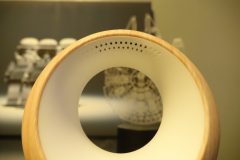 At the bottom of the front are the logo, microphone, and light sensor, and towards the middle of the centre are the RGB LED lights. On the underside of the top of the unit are several tiny dot openings, which are for releasing the ions to help purify the room’s air.
At the bottom of the front are the logo, microphone, and light sensor, and towards the middle of the centre are the RGB LED lights. On the underside of the top of the unit are several tiny dot openings, which are for releasing the ions to help purify the room’s air.
At the top, you’ll find the power/reset button, and on the back are the speakers and a covered port for connecting the USB power cord. Also discreetly located there is a temperature and humidity sensor. The cover pulls out to reveal the USB port-be careful, as removing it accidentally could damage the temperature sensor.
How to set up the iBaby Airsense air monitor & ion purifier
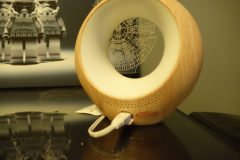 Setup was super simple: plug the unit into power, download the iBaby Care app from the iOS or Android app store (I used an iPhone 6S), make sure your phone is connected to your home’s Wi-Fi network, then power on the iBaby. It will immediately glow bright pink. When it turns to a pulsing blue, connect through the app. If it turns orange, you’ve run into some trouble and should try again. If it works successfully, you’ll see the blue light begin to rotate, and the app will notify you. It takes about 30 seconds.
Setup was super simple: plug the unit into power, download the iBaby Care app from the iOS or Android app store (I used an iPhone 6S), make sure your phone is connected to your home’s Wi-Fi network, then power on the iBaby. It will immediately glow bright pink. When it turns to a pulsing blue, connect through the app. If it turns orange, you’ve run into some trouble and should try again. If it works successfully, you’ll see the blue light begin to rotate, and the app will notify you. It takes about 30 seconds.
I did run into a small issue, and it’s one I’ve run into before: because my home’s Wi-Fi network name (the SSID) has special characters in it, the iBaby could not connect to it. I rectified this by changing the network name to something that only contained letters and numbers, and it connected immediately. You likely won’t run into this issue if you have a  standard SSID name just letters and numbers, but it’s worth mentioning for troubleshooting purposes.
standard SSID name just letters and numbers, but it’s worth mentioning for troubleshooting purposes.
Using the iBaby Airsense App
In the Home screen, you’ll see a number attributed to the VOC, the temperature in the room as well as a description (e.g. warm, cold); the moisture level by percentage and description (e.g. dry or normal), and the purifier’s status-is it on or off?
At the time of this writing, the VOC level in my son’s room was 4. Based on the VOC reading guide provided in the app, from 0-25 is superb, 25-50 is poor, 50-75 is oops, and 75-100 means you may be putting yourself at risk as the air quality is dangerous. Thankfully, through my weeks of using it, we only ventured into the poor category once, and I’m still trying to determine the cause. The guide also confirms that a healthy level of humidity is typically between 30 and 60%. My son’s room usually sat around 38%. A quick glance at the actual device will also give you an indication of the air quality, as it will glow in the related colour:  green for s
green for s uperb, yellow for poor, and so on.
uperb, yellow for poor, and so on.
I wish, however, that the app provided more actionable insights.
For example, if you click the graph icon to the left, you can see a history of VOC levels by week, month, or just for the current day. I can see when the number dropped and rose, and detect patterns – it often seemed to rise first thing in the morning, or late at night. But I don’t know what to do with this information. Of course, you could use the details to determine when to turn the purifier on, or simply to have knowledge of when the purifier is working its hardest. But I wish I had more of an understanding of how I can use this information to improve the air quality at home.
There is, however, a small educational component with an Air Hints button on the home page. It provides some general tips on improving the air quality in your home, like avoiding the use of toxics paints and smoking in the home, as well as keeping your windows open,  and growing plants. It would have been great if the hints were directly related to the personal data being recorded by my purifier itself. Like “I see that the level of VOCs rises during a specific time. You might want to consider doing X in order to help the purifier best do its job.”
and growing plants. It would have been great if the hints were directly related to the personal data being recorded by my purifier itself. Like “I see that the level of VOCs rises during a specific time. You might want to consider doing X in order to help the purifier best do its job.”
All that said, the point of the AirSense isn’t so much to educate you on how to understand VOCs and the air quality in your home, but for the iBaby to quietly clean the air for you. And if, for any reason, a real issue is detected with VOCs, temperature, or humidity, the iBaby will send an alert via the app to let you know so you can take the necessary actions. Thankfully, I never had to receive one of these alerts.
An Air Station section of the app is supposed to show you how others around you relate in terms of air quality, but the function didn’t seem to work for me, only a showing a “we’re working on it” image and message.
Other features of the iBaby Airsense air monitor and purifier
Beyond its air purifying capabilities, the iBaby also has some interesting functions. Tap the Listen button in the app to use your phone as a baby audio monitor, or press Talk for it to function as a radio to soothe your baby, or let your twins know they need to stop playing 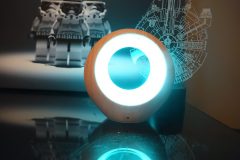 around and get some shuteye. Set an alarm from the device, either individual or recurring, and press the Light Up button to control light output, including turning it on or off and adjusting brightness.
around and get some shuteye. Set an alarm from the device, either individual or recurring, and press the Light Up button to control light output, including turning it on or off and adjusting brightness.
It also works as a WiFi speaker with an integrated music library, playing a selection of lullaby tunes, like Twinkle Twinkle Little Star, or fun play songs, like If You’re Happy and You Know It. You can also add music from your own library.
Additionally, you can invite other users, like a spouse or babysitter, to access the app and view the status.
You can also set a preferred temperature range from the app, then be notified if the room temperature becomes to cold or hot.
Would I buy the iBaby Airsense?
All in all, the iBaby Airsense is an affordable and sleek-looking device that can help you monitor and clean the air in your baby’s or child’s room. The information provided in the app won’t rival other smart connected purifiers that come at much higher prices. But that is to be expected. But it makes a perfect gift for anxious parents who might have suspicions about the quality of air in their residence, and want to ensure the best for their baby.

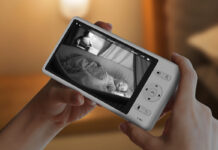


This looks like a ready good and helpful production.
Great info for people looking to put an air purifier in their house. Just to follow up on the HEPA comment…
An ionizer charges the pollutant particles in the air so that they are deposited on a surface. A simple high voltage needle ionizer creates a deposit of black dirt around itself. Ionizers are thus best used in conjunction with a full air filtration system which ionizes the clean air coming out of the unit. There is no room for a fan driven filtration system in something this small – surely? A removable and cleanable filter is required.
agreed
what about dust ? it purifies dust, how ? where does the dust go ? must you clean the purifier, if so how ?
or is its function just to let you no that dust is present ?
Interesting review, but without an independent measure of air quality, your review doesn’t mean much in terms of whether or not the thing actually works. Even more troubling is the fact that, even though you had an air purifier on, the air quality was rated by the machine itself as poor at one point. Isn’t the point of an air purifier to ensure that the air quality is never poor? Well-written review, but in terms of deciding whether or not to buy an air purifier, absolutely useless.
Comments are closed.